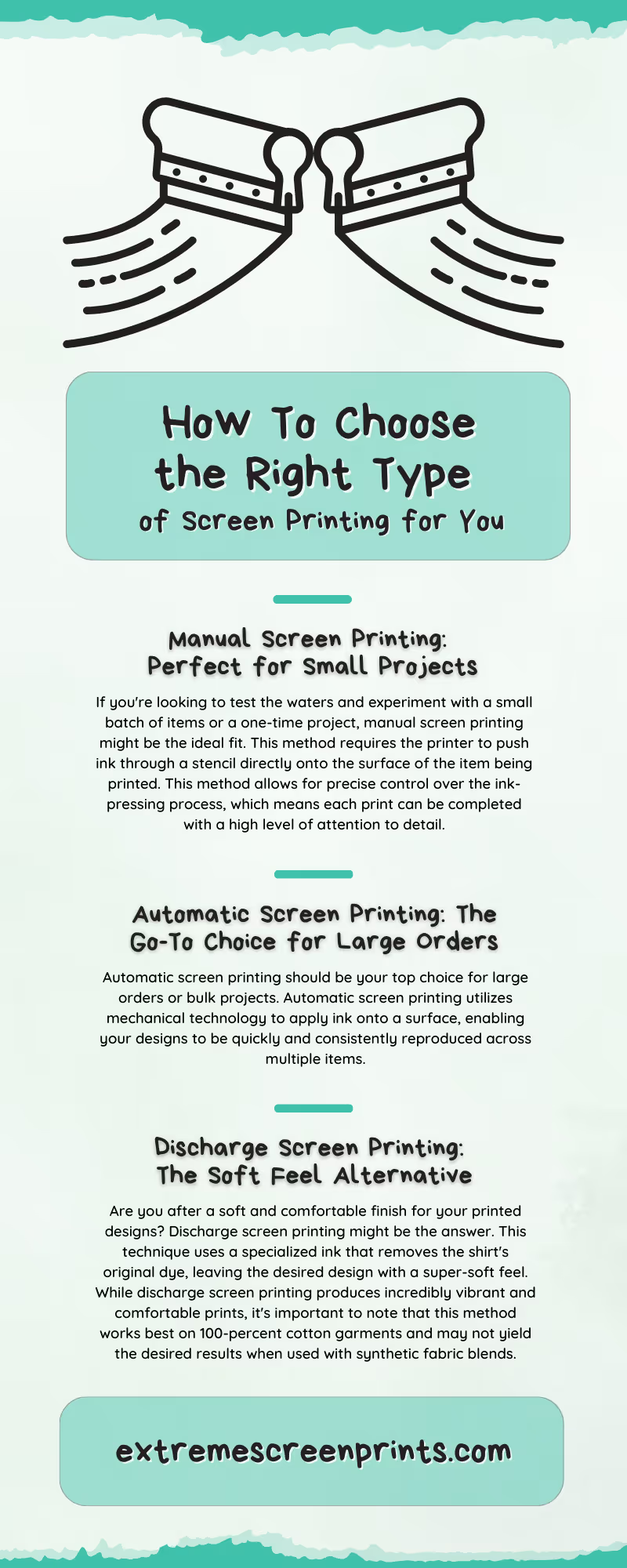



Screen printing is a versatile and cost-effective method when it comes to customizing apparel and promotional items or even creating your own line of products. With various types of screen printing available, it's essential to understand which one is best suited for your needs.
If you want to know how to choose the right type of screen printing for you, knowing the differences between each type and how they work is crucial. Learn more about the most common types of screen printing techniques here.
Screen printing is a versatile and popular method for transferring designs onto apparel such as t-shirts, sweatshirts, and more. The process involves creating a stencil, known as a screen, and using it to apply layers of ink onto the fabric. Each color in the design requires a separate screen. A multicolored design would be built up layer by layer, creating a vibrant and long-lasting print.
The type of screen printing you choose can have a big impact on the final durability, feel, and appearance of your custom apparel. Different types of screen printing work better for specific purposes and materials, which is why understanding the available options can help you make an informed decision and achieve the best possible outcome for your project.
Moreover, selecting the most suitable method based on your design and the type of apparel you're using is essential to ensure consistent and professional results. This decision will influence the final product as well as the cost, production time, and overall success of your custom apparel project.
There are several popular types of screen printing, each with its advantages and challenges. Let's look at some of the most common methods to help you better understand which one is right for you.
If you're looking to test the waters and experiment with a small batch of items or a one-time project, manual screen printing might be the ideal fit. This method requires the printer to push ink through a stencil directly onto the surface of the item being printed. This method allows for precise control over the ink-pressing process, which means each print can be completed with a high level of attention to detail.
However, keep in mind that manual screen printing can be labor-intensive, making it less suitable for large or high-volume projects.
Automatic screen printing should be your top choice for large orders or bulk projects. Automatic screen printing utilizes mechanical technology to apply ink onto a surface, enabling your designs to be quickly and consistently reproduced across multiple items.
This method is time efficient. It also reduces human error, ensuring every print is consistent in quality and appearance. It is particularly useful for businesses or individuals looking to mass-produce custom garments, promotional items, or other printed merchandise.
Are you after a soft and comfortable finish for your printed designs? Discharge screen printing might be the answer. This technique uses a specialized ink that removes the shirt's original dye, leaving the desired design with a super-soft feel.
While discharge screen printing produces incredibly vibrant and comfortable prints, it's important to note that this method works best on 100-percent cotton garments and may not yield the desired results when used with synthetic fabric blends.
If you're looking to add a unique touch to your designs, special effects screen printing can open up a world of possibilities. From reflective and glow-in-the-dark inks to foil, flock, and glitter, this technique lets you experiment with a variety of textures and finishes to make your prints truly stand out.
That said, creating custom special effect designs can be more costly than using other types of screen printing, so be sure to consider your budget when choosing this option.
Another popular type of screen printing is sublimation, which involves transferring designs onto light-colored synthetic fabrics, such as polyester or nylon. This technique uses heat to vaporize the ink, allowing it to penetrate the fabric's fibers and create a long-lasting, vibrant print.
Sublimation printing is ideal for creating full-color designs and photographic prints, making it a popular choice for sports uniforms, team jerseys, and other performance apparel. Keep in mind that sublimation printing only works on light-colored fabrics, so it may not be suitable for every project.
High density screen printing, also known as puff or 3D printing, is a technique that adds depth and texture to your designs. This method uses a specialized ink that expands when heated to create raised areas on the print, giving it a tactile feel.
High density screen printing is commonly used for bold lettering and logos, as well as designs that require a pop of texture. It's also a great option for creating eye-catching promotional items or adding dimension to your custom apparel.
But keep in mind that high density screen printing is not suitable for intricate designs or small details. Additionally, this method can be more expensive than traditional screen printing techniques due to the specialized ink and equipment required.
Now you know how to choose the right type of screen printing for you. When deciding which type of screen printing is best for your needs, consider factors such as the complexity of your design, the type of garment or material you're using, and your budget and timeline. By carefully considering these elements, you can select the perfect method to achieve high-quality and professional results in all your screen printing projects.
For superior quality and expert guidance that meets your customization needs, you can always turn to Extreme Screen Print's screen printing services. Our team of skilled professionals is here to help you achieve the perfect print for any project! Prepare to bring your creative vision to life with the right type of screen printing services tailored just for you.
